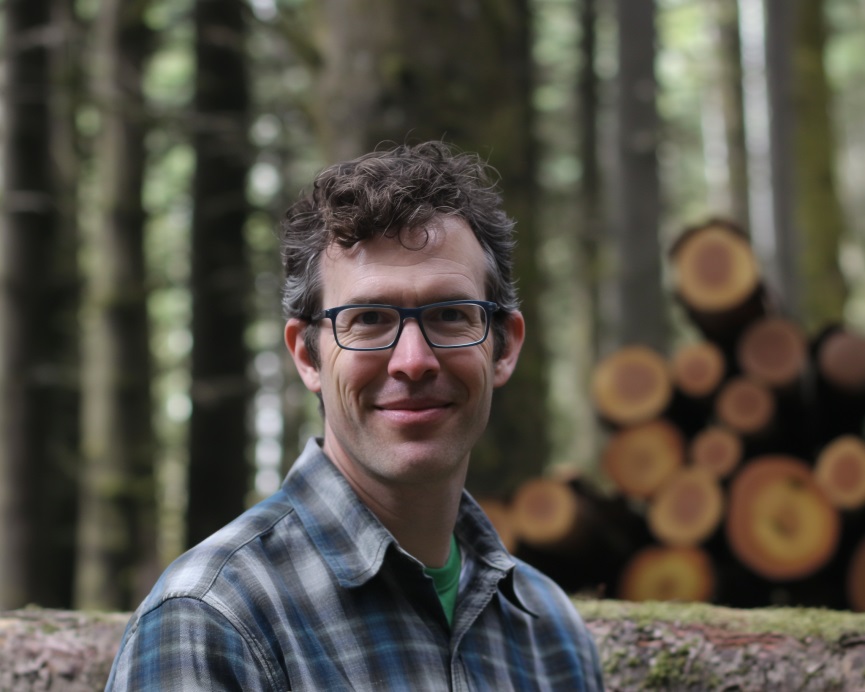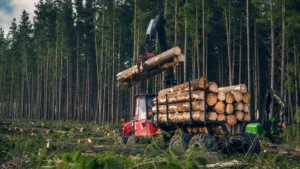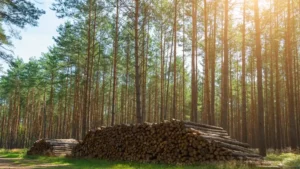Timber Investment: A Secure Path to Long-Term Wealth
- September 9, 2024
- 0 comment
Timber, often overlooked in the realm of conventional investments, is increasingly recognized as a valuable and stable asset. For centuries, timber has been a cornerstone of human development, from providing basic shelter to fueling industrial growth. Its role in construction, energy, and as a raw material in countless products has ensured its perpetual demand. Yet, it’s only in recent decades that investors have begun to appreciate timber’s potential as a formidable investment vehicle.

Historically, timber has proven resilient through economic downturns, making it an appealing option for those seeking stability. The current market trends underscore timber’s potential, with demand growing due to its role in sustainable development and the green economy. The advantages of investing in timber are numerous, including its role as a hedge against inflation, its tangible nature, and its capacity for long-term growth.
The Global Demand for Timber Investment
The global demand for timber is rising, driven by factors such as the increasing population, urbanization, and the expansion of emerging markets. In countries like China and India, rapid urbanization has led to a surge in construction, subsequently increasing the demand for timber. Moreover, timber’s role in sustainable development cannot be overstated. As the world shifts towards eco-friendly resources, timber, with its renewable nature, stands out as a key player in this transition.
Urbanization and population growth are also critical drivers of timber demand. As cities expand, so does the need for housing, infrastructure, and other construction materials, all of which rely heavily on timber. This consistent demand, coupled with timber’s sustainable attributes, positions it as a vital resource for future development.
Types of Timber Investments
Investors can choose from various types of timber investments, each with its unique characteristics and potential returns. Direct ownership of timberland is one of the most traditional forms of investment. This involves purchasing land with standing timber, which can be harvested and sold. Timberland can appreciate over time, providing capital gains in addition to income from timber sales.

Timber Real Estate Investment Trusts (REITs) offer another avenue for investment. These are companies that own and manage timberland, and they trade on stock exchanges like other REITs. Timber REITs provide exposure to timber markets without the need to directly own land, making them accessible to a broader range of investors.
| Type of Timber Investment | Potential Returns | Risks | Key Considerations |
|---|---|---|---|
| Direct Ownership of Timberland | 5% – 8% annually from timber sales and land appreciation | High initial cost, environmental risks (fires, pests) | Requires hands-on management; long-term commitment |
| Timber REITs | 3% – 6% dividend yield; potential capital appreciation | Market volatility, economic cycles | More liquid than direct ownership; easier access |
| Mutual Funds & ETFs | 4% – 7% depending on fund performance | Market risk, management fees | Diversification across timber-related companies |
| Private Equity in Timber | 7% – 12% based on project success | High risk, long lock-in periods | Suitable for high-net-worth individuals; potential for high returns |
Mutual funds and ETFs focused on timber allow for diversified exposure to the timber market, investing in companies involved in timber production, processing, and related industries. Private equity in timber offers opportunities for more significant, longer-term investments, often involving the acquisition and management of large tracts of forested land.
Evaluating the Financial Performance of Timber
The financial performance of timber as an investment is compelling, particularly when considering its historical returns. Over the past several decades, timber has delivered consistent returns, often outperforming other asset classes during periods of inflation. This makes timber an attractive hedge against rising prices, preserving wealth while providing income.

Timber’s performance compared to other assets, such as stocks and bonds, highlights its unique attributes. Unlike most assets, timber grows organically, increasing in value as trees mature. This biological growth, coupled with the potential for land appreciation, offers investors dual sources of return. Furthermore, timber’s low correlation with traditional financial markets enhances its appeal as a diversification tool.
The Long-Term Growth Potential of Timber
Timber’s long-term growth potential is anchored in its resilience to economic downturns and its status as a renewable resource. Unlike other commodities, timber is less susceptible to market fluctuations, as trees continue to grow regardless of economic conditions. This growth, coupled with the increasing value of timberland, provides investors with a reliable source of long-term returns.
| Growth Factor | Expected Annual Growth Rate | Potential Risks | Key Insights |
|---|---|---|---|
| Biological Growth of Trees | 4% – 6% | Climate change, natural disasters | Trees increase in volume and value over time |
| Timberland Value Appreciation | 3% – 5% | Land use changes, regulatory risks | Land value typically increases alongside timber |
| Rising Demand for Sustainable Resources | 5% – 7% | Market saturation, shifts in material preferences | Growing interest in eco-friendly products boosts demand |
| Inflation Hedge | 2% – 4% above inflation rate | Economic downturns, price volatility | Timber prices often rise with inflation, preserving value |
The demand for eco-friendly resources further bolsters timber’s growth potential. As more industries and consumers prioritize sustainability, the demand for timber, a renewable and biodegradable resource, is expected to rise. This trend positions timber as a crucial resource in the green economy, with significant implications for its long-term investment potential.
Risks and Challenges in Timber Investment
Despite its many advantages, timber investment is not without risks. Market volatility and economic cycles can impact timber prices, affecting the returns on investment. Additionally, environmental risks, such as climate change and natural disasters, pose significant challenges to timber investments. Forests are vulnerable to events like wildfires, storms, and pests, which can devastate timberland and reduce yields.
| Risk/Challenge | Potential Impact | Likelihood | Mitigation Strategy |
|---|---|---|---|
| Market Volatility | Fluctuations in timber prices | Medium | Diversify investments; focus on long-term holding |
| Environmental Risks | Loss of timber due to fires, pests, storms | High | Invest in insurance; choose geographically diverse locations |
| Regulatory and Policy Risks | Changes in land use laws, taxes | Medium | Stay informed on local regulations; engage legal counsel |
| Climate Change | Reduced growth rates, increased frequency of natural disasters | High | Invest in resilient species; monitor climate trends |
| Economic Cycles | Lower demand during recessions | Medium | Maintain liquidity; consider counter-cyclical strategies |
Regulatory and policy risks also play a role, as changes in land use regulations, environmental protection laws, and trade policies can influence timber markets. Investors must navigate these challenges carefully, balancing potential rewards with the associated risks.
Timber as a Diversification Tool
Timber offers significant benefits as a diversification tool within an investment portfolio. Its low correlation with other asset classes, such as stocks and bonds, means that timber can reduce overall portfolio risk. By including timber in a balanced investment strategy, investors can achieve greater stability and potentially enhance long-term returns.

Timber’s unique attributes make it particularly valuable in a diversified portfolio. Its biological growth ensures that it continues to generate value over time, while its tangible nature provides a hedge against inflation and currency devaluation. This makes timber an effective component of a well-rounded investment strategy.
The Role of Timber in Sustainable and Ethical Investing
Timber plays a pivotal role in sustainable and ethical investing, contributing to environmental conservation and carbon sequestration. Forests act as carbon sinks, absorbing CO2 from the atmosphere and mitigating the effects of climate change. Investing in timber, particularly in sustainably managed forests, aligns with the goals of ethical investors who prioritize environmental stewardship.
The Forest Stewardship Council (FSC) certification ensures that timber is harvested responsibly, preserving biodiversity and supporting local communities. Ethical investing in timber not only yields financial returns but also contributes to the broader goals of sustainability and conservation.
Geographic Considerations for Timber Investment
The geographic location of timber investments significantly impacts their potential returns and risks. North America, with its vast tracts of timberland, remains a leading region for timber investment. The United States and Canada offer stable legal frameworks, well-established markets, and high-quality timber, making them attractive destinations for investors.
Latin America and Southeast Asia present emerging opportunities, with vast forests and growing demand for timber products. However, these regions also carry higher risks, including political instability, environmental degradation, and challenges related to land tenure. Investors must weigh these factors when considering geographic diversification in timber investments.
Technological Advances in the Timber Industry
Technological advancements are transforming the timber industry, improving efficiency and sustainability. Innovations in timber harvesting and processing have reduced costs and environmental impact, making timber production more sustainable. Advanced techniques such as precision forestry, which uses data and technology to optimize forest management, are revolutionizing the industry.

Timber is also gaining prominence as a construction material, with engineered wood products like cross-laminated timber (CLT) offering strength and sustainability. These innovations position timber as a key resource in the future bioeconomy, with implications for its investment potential.
How to Get Started with Timber Investments
Investing in timber requires careful planning and consideration of various factors. The first step is to assess your investment goals and determine how timber fits into your overall strategy. Whether you’re seeking long-term growth, income, or diversification, timber offers unique opportunities that can align with different objectives.
| Step | Estimated Cost | Time Commitment | Considerations |
|---|---|---|---|
| Assess Investment Goals | Minimal (personal research) | 1 – 2 weeks | Define risk tolerance, investment horizon, and objectives |
| Identify Investment Vehicles | $0 – $100 (research, advisory fees) | 2 – 4 weeks | Choose between direct ownership, REITs, mutual funds, or private equity |
| Due Diligence | $500 – $5,000 (legal, appraisal fees) | 1 – 3 months | Evaluate property quality, market conditions, and legal aspects |
| Initial Investment | $5,000 – $100,000+ | Varies by investment type | Consider capital outlay for land purchase, REIT shares, or fund units |
Identifying reliable investment vehicles is crucial. Investors can choose from direct ownership of timberland, REITs, mutual funds, and private equity. Due diligence is essential, as it involves evaluating the quality of the timberland, understanding market dynamics, and assessing risks such as environmental factors and regulatory changes.
Scenario Analysis: Successful Timber Investments
Real-life case studies provide valuable insights into the potential of timber investments. Notable timberland acquisitions, such as large-scale purchases by institutional investors, highlight the returns achievable in this asset class. These cases demonstrate the importance of strategic location, sustainable management practices, and long-term planning in achieving successful outcomes.
Timber REITs have also shown strong performance, with consistent dividends and capital appreciation. These case studies illustrate the diverse opportunities available in the timber market and the factors that contribute to successful investments.
Timber in the Context of Climate Change
Timber’s role in the fight against climate change is increasingly recognized. As a carbon-neutral resource, timber can help reduce greenhouse gas emissions by substituting for more carbon-intensive materials like steel and concrete. The use of timber in construction, particularly in sustainable building practices, contributes to the reduction of carbon footprints.
However, climate change also poses risks to timber investments. Changes in temperature, precipitation, and the frequency of natural disasters can affect forest health and timber yields. Investors must consider these factors and adopt mitigation and adaptation strategies to safeguard their investments.
Ethical and Environmental Considerations
Timber investment intersects with ethical and environmental considerations, particularly regarding its impact on indigenous communities and biodiversity. Deforestation, driven by the demand for timber, poses significant environmental challenges, including habitat loss and climate change. Balancing profit with environmental stewardship is essential for responsible timber investing.
The debate over deforestation underscores the importance of sustainable forestry practices and the need to protect vulnerable ecosystems. Investors should consider the broader impact of their timber investments, ensuring they contribute to positive environmental outcomes while achieving financial returns.
Final Conclusion
The future of timber investment looks promising, driven by the growing appeal of green investments and the increasing demand for sustainable resources. Timber’s long-term trends, including its role in carbon sequestration, renewable energy, and sustainable construction, position it as a key asset in the transition to a green economy.
For investors seeking stability, diversification, and long-term growth, timber offers a unique opportunity. However, like any investment, it requires careful consideration of risks and challenges. By understanding the factors that influence timber markets and adopting a strategic approach, investors can capitalize on the enduring value of timber as an investment.
Frequently Asked Questions (FAQs)
- What makes timber a good investment?
Timber is a strong investment due to its consistent demand, biological growth, and potential to hedge against inflation. It also provides diversification benefits and long-term value appreciation. - How does timber investment compare to other asset classes?
Timber investments often outperform other assets during inflationary periods and economic downturns. Timber has low correlation with stocks and bonds, making it a valuable addition to a diversified portfolio. - What are the main types of timber investments?
The main types include direct ownership of timberland, Timber REITs, mutual funds, ETFs focused on timber, and private equity in timber-related projects. - What are the risks associated with timber investments?
Risks include market volatility, environmental factors like wildfires and pests, regulatory changes, and the impact of climate change on forest growth and yields. - How does timberland value appreciate over time?
Timberland value increases as the trees mature and grow in volume, and land itself often appreciates due to its finite nature and increasing demand for natural resources. - Is timber a sustainable and ethical investment?
Yes, timber can be a sustainable investment if sourced from responsibly managed forests. It contributes to carbon sequestration, supports biodiversity, and can be part of ethical investment portfolios. - What geographical regions are best for timber investment?
North America, particularly the United States and Canada, offers stable investment opportunities. Emerging markets in Latin America and Southeast Asia also present high-growth potential but with higher risks. - How can I get started with timber investments?
Start by assessing your investment goals, identifying suitable investment vehicles (like REITs or direct ownership), and conducting due diligence on market conditions and specific properties. - What are the tax implications of investing in timber?
Tax implications vary by region, but timber investments often qualify for favorable tax treatments, such as capital gains tax rates and potential deductions for forest management expenses. - Can timber investment withstand economic downturns?
Timber investments tend to be resilient during economic downturns due to the continuous biological growth of trees and stable demand for timber products.

James Wilson
Forestry AuthorJames Wilson has over 15 years of experience in forestry economics, specializing in sustainable practices, investment opportunities, and financial management. He has contributed to notable publications like "Forestry Today" and "EcoFinance Journal" and is known for providing practical and insightful advice. With a degree in Environmental Economics, James stays updated through continuous learning and active participation in industry discussions. Outside work, he enjoys hiking and nature photography, bringing a well-rounded perspective to his professional role.












Leave your comment